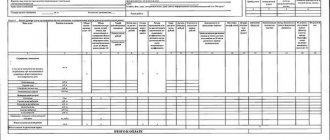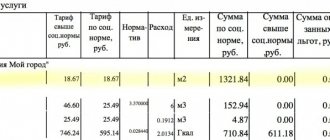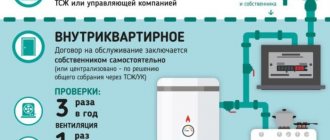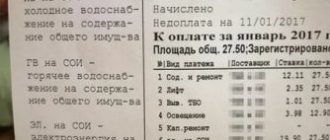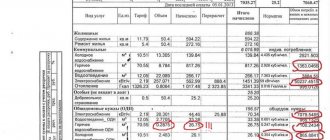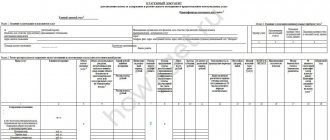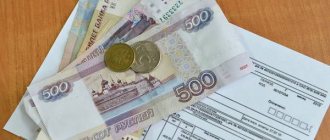Cost optimization algorithm
First of all, it is worth installing meters for hot and cold water, since the cost of these devices on average ranges from 4,000 to 6,000 rubles, and these costs are recouped in an extremely short time. In the vast majority of cases, the savings per year range from approximately 30% to 50% compared to the fee provided by law.
There are also various services on the receipt that many may consider completely meaningless. The most significant thing in this case is the maintenance of a radio point, since in accordance with current legislation, any residential or non-residential premises must be connected to a wired broadcast network.
To get rid of this service, it is enough to contact the Federal State Unitary Enterprise, and this can be done even remotely by submitting an appeal to the email address of the specified service.
You may have to wait about a month for a response, and it will not be physically possible to turn off the radio point, as a result of which a date for this operation will be pre-agreed on one of the weekdays.
Another common service, which is often not used by residents of many houses, is a collective antenna, which has to be paid for in the amount of 80 to 120 rubles per month, even if a person basically does not have a TV. In such a situation, you need to find out the name of the supplier company (which should be written on the receipt), and then apply to the management organization or HOA to order a recalculation of the rent.
In the same way, it is worth noting landline telephones, which today are no longer used by the vast majority of modern citizens, but can be connected in the house, and therefore they have to be paid in accordance with established tariffs.
Among other things, do not forget that if a person is absent from his home for more than five days, he is given the right to refuse to pay for certain utilities, such as operating the elevator installed in the house or garbage collection. In addition, various utility resources for which meters were not installed are not paid for.
You can find out the rent on your personal account through the online service of Sberbank or at the housing office.
How to find out rent arrears by address - see here.
Water supply
Water supply usually includes everything related to water in the apartment, but in fact it is a narrower term, although it includes not only the supply itself. It includes the preparation, transportation and supply of water to apartments. In this case, both centralized and non-centralized hot and cold water supply systems can be used, which must also be filled out separately on the receipt.
Preparation includes filtration and purification, composition analysis - all this must be controlled so that the consumer receives clean, high-quality water. For transportation and supply, it is necessary to maintain the condition of water pipelines, maintain pumping stations, and so on - this is where the money that consumers pay for water goes. With regard to hot water, we should not forget about the maintenance of boiler rooms, which also requires funds - that’s why it costs more.
Cold (CW)
Cold water supply implies the provision of cold water of established quality, uninterrupted throughout the day (except for the period allocated for breaks). In this case, water must be supplied directly to the living space, or to the water intake column, and in the required volume. These requirements are formulated in Government Decree No. 354, and the supplier must strictly comply with them in order to charge for their services in accordance with the established tariff.
As for permissible interruptions in the supply of cold water, they amount to no more than eight hours in total per month, and no more than four hours at a time. Breaks of this length are allowed in case of malfunctions in the centralized cold water supply network. These standards are established in the Construction Codes and Regulations (SP 31.13330.2012). If the period is exceeded, then the water fee must be recalculated.
Hot (DHW)
Hot water supply also involves preparation, transportation and supply, but only hot water. In general, for the consumer it is not much different from cold water, but technically there are certain nuances, as a result of which the requirements for it are slightly different.
So, although the standard duration of breaks in the supply of hot water is the same as for cold water, that is, four hours at a time and eight in total per month, a couple more options are added. In the event of an accident on a dead-end highway, a break in the supply of one day is allowed; an annual interruption of supply for repair work is also provided. In accordance with SanPin 2.1.4.2496-09, the duration of such work can be up to two weeks; they are usually carried out in the summer.
The maximum deviation of water temperature has also been established: in the daytime it should be no more than three degrees Celsius, and at night (that is, from midnight to five o’clock in the morning) – five.
As for payment for water consumption, the abbreviation PC can be found on the receipt - it will mean an increasing coefficient. This is relevant for residents who have not installed meters.
Paying for water supply is not difficult to figure out. You can calculate the cost of consumed water by multiplying the number of cubic meters of water used by the number indicated in the “tariff” column. Often the result is quite impressive. But there is hardly any point in arguing about the need to pay for this service. A person pays for the purified water he uses. He cannot pay more than he spent thanks to the installed meters. But what is drainage on the receipt?
Everything related to water supply is in this document in the columns “DHW” and “CW”. Why do you need to pay for another, additional service?
What receipts should come for an apartment?
It should be noted that there is no single form of receipt for housing and communal services that is mandatory for everyone. In different regions, cities, even houses, the management and supply of utility resources occurs differently. Therefore, the payment card may differ in appearance, shape, and color. It may consist of two parts: a notice and a receipt, or it may take the form of a single document.
Officially by Order of the Ministry of Construction No. 924/pr. from the city only an approximate form of rent receipts was approved. However, this document is only advisory in nature, its use is not mandatory.
Due to changes in housing legislation that came into force at the beginning of this year, this sample model has also undergone some additions. But, in general, the structure of the document remains the same.
Next, we will figure out what is included in this document, what is the basis for payment on the receipt.
In fact, any receipt should include the following information:
- about the payer and recipient of payment for housing and communal services (full name, name of organization, TIN, bank details, personal account number);
- information about the residential premises (area of the apartment, the house as a whole, address, number of residents);
- calculation of payments for each type of services provided;
- reference Information.
Tariffs and reflection in the law
In accordance with current legislation, a tariff is a specific unit of change that regulates the cost of providing various public services. They are based not only on the initial cost of the product provided, but also on various costs that the supplier will have to bear in order to provide certain utility services to potential consumers.
In the vast majority of cases, modern citizens consider it an extremely simple option to achieve savings on utility bills by changing the standard tariff schedule, which calculates the final cost of the consumed product, but in fact, suppliers are not the sole administrators of tariffs.
Any adjustments that will be made to the cost of each individual unit of resource are carried out in accordance with the requirements prescribed in various regulations adopted by executive authorities.
The total cost of a standard receipt basically includes the cost of the service provided, multiplied by the amount of resources consumed over a certain period of time, or the cost established in accordance with average standards.
All issues related to the residence of citizens in multi-apartment buildings are spelled out in the current Housing Code. They also regulate the procedure for payment and provision of various utility services, as well as requirements for the fulfillment of obligations on the part of service providers.
In particular, Article 153 of the Housing Code clearly establishes the obligation of owners or authorized tenants of real estate to pay for all necessary housing and communal services. In addition, over the past few years, property owners must bear responsibility for common property and maintain it in appropriate condition.
Article 153. Obligation to pay for residential premises and utilities
Decoding the housing and communal services receipt 2021, how to understand the services and what is included in them
This includes rent, capital and current repairs, housing and communal services, etc.
It is also important to determine the basis on which the total amount payable is formed.
First of all, the formation of payments is influenced by contracts concluded by citizens and government organizations (for example, a social rental agreement).
Particular attention should be paid to regulations adopted in the region on the provision of utility services.
You also need to take into account the tariffs in force in the constituent entity of the Russian Federation.
The readings of meters installed in citizens’ apartments are also very important. In this situation, it is necessary to identify what kind of lease is taking place.
If this is a social rental, then the rent for housing is also included in the communal apartment. In situations where there is a civil lease, the rent is addressed directly to the landlord, and the tenant can actually pay it.
The concept of a single payment document
A single payment document is generalized information that allows the payer to make payments for the provided housing and communal services.
It includes:
- Information about the payer - full name or company name, location address.
- Recipient details and bank details for payment.
- Volume and cost of housing and communal services provided during the reporting period.
That is, a single payment document contains a comprehensive amount of information about expenses that are subject to reimbursement. This includes payments for utilities and building maintenance.
Payment Methods
To make payments for housing and communal services, the payer can use a variety of methods:
- Payment via bank. Upon receipt of the receipt, the payer will have to appear in person at the specified organization, submit a payment document in a first-come, first-served manner and deposit funds. It should be noted that this option is not the most profitable from a financial point of view, since many banks charge a commission for providing the service.
- Payment via mail. This option also requires the person to appear in person. As in the case of a bank, a commission will be charged for providing the service. Its size will be one and a half percent of the payment amount.
- Payment via ATM. This method saves a person from standing in line, unless it has formed near the device itself. In this case, you can not take into account the opening hours of branches and branches, since ATMs are also located on the street. But in this case, the person will be required to enter all the data independently. It is impossible to get specialist advice in such a situation. In the device menu, you must select the appropriate function and carefully fill out the form that opens. After this, the funds will be debited from the card, and the payer will receive a receipt.
- Payments are made through terminals in the same way. This option allows for assistance from a specialist, since the devices are located, including in bank branches.
- Pay online, via the Internet, no need to come anywhere. In this case, a person will need to register on a specialized website, for example, State Services, and create a personal account. After this, enter your login and password to log into your account, and select the required function. This is followed by filling out a special form and confirming payment. At the end, the person will receive an email notification that the operation has been completed.
- Automatic payment. To use this method, you must activate the service at the bank that services the payment card and set the date for debiting the funds. This option allows a person not to perform any actions. The commission for the service provided is lower than if you pay in person, through an ATM or terminal.
- Using mobile notifications. To do this, the bank must provide services of this nature. When performing an operation, the payer sends a mobile notification indicating the payment amount that will be debited from the account.
A person can choose any of the options at his personal discretion, based on the current situation and his capabilities.
Decoding the receipt
When drawing up a receipt for housing and communal services, a lot of abbreviations are used; this is necessary in order to reduce the amount of information in order to include it in the content of the document. However, most people do not know the meaning of the abbreviations used. Such situations create a lot of questions for payers who begin to check their accounts.
The abbreviations used when preparing a payment document for housing and communal services can be deciphered as follows:
- SEON – public emergency warning system. This mainly concerns natural disasters.
- SOI – maintenance of common property. This includes costs for flights of stairs, attics, elevators, entrances, and dryers.
- ROM – intercom and locking device. This applies to intercom fees.
- ODN - general house needs. This is a complete analogue of SDI. Each of these abbreviations can be used by the management organization.
- UUTE – thermal energy metering units. The amount of heat supplied to the premises is indicated here. The size of a payment of this nature depends very much on the time of year.
- DSCPT – additional cable program television systems. This includes payment for telecommunications services and maintenance of a common antenna.
- POVK. This abbreviation refers to the provision of heat and heating. It can be supplemented with the letters ТВХ.
- APPZ – automated fire protection. Equipment of this nature ensures the safety of not only housing, but also common areas - stairwells, entrances, attics.
- AUR – administrative and managerial work. Such a payment ensures the functioning of the management company.
- OPU is a general metering device. Such costs are associated with the installation of equipment. This is general metering equipment, for example, water meters in apartment buildings.
- ELDT. This abbreviation refers to energy consumption during the daytime.
- TPP. The flow rate of water used as a heat source is indicated here.
- VDGO – in-house gas equipment. This includes inspection, repair and maintenance of gas stoves, boilers and water heaters.
- NPD – payment document number.
- DHW – hot water supply. If a heating column is installed at home, there is no charge.
- Cold water supply - cold water supply.
This will help you better understand what's on your receipt.
A fee is also charged for wastewater disposal. In this case, the invoice is issued by the management company.
TPP
includes payment for water - “coolant”. VDGO The interpretation of this concept includes the provision and maintenance of gas equipment. VDGO includes stoves, gas boilers, and water heaters.
Citizens are required to pay for inspection, repair and maintenance of these devices. PD number This is the payment document number!
It is used by housing and communal services management companies, and it is also convenient for the tax inspectorate and other organizations.Water disposal in housing and communal services receiptsCitizens are also required to pay for wastewater disposal. Payment for this is charged every month.
The management company issues such a receipt and also issues an invoice for the disposal. Water supply A separate column indicates hot water supply and hot water supply.
This is, in essence, the supply of hot and cold water to the apartment. This is done through common pipes. GVSGVS means the provision of hot water supply.
The column must be filled out in accordance with legal requirements. There is no charge for the consumption of hot water in a situation where there is a water heater at home. HVS This is the supply of cold water to the apartment. Payments are collected based on common metering devices (shared in the building) or on individual ones located in the apartment.
The calculation is generated for a certain period. Heating Abbreviations for heating have already been discussed above. It should be noted that the provision of this service is seasonal and, for example, in the summer, no payment for heat is charged.
Payment shelf life
The law does not establish an obligation for a person to keep receipts for payment for housing and communal services.
However, the Civil Code establishes such a concept as a statute of limitations; if it has passed, then the court refuses to collect the debt. In the event of a dispute regarding payment for housing and communal services, the document confirming the fact of payment is a receipt. For this reason, it is recommended to save them for at least three years from the date of depositing funds. Although it is better if it is stored for five or more years.
It should be noted that if the payment receipt has become unusable or lost, it can be restored by contacting the organization that accepted the payment. After this, the initiator will be given a copy of the document.
Prohibition of advertising on payment cards
The payment document, in essence, is a source of information about the amounts of expenses for housing and communal services.
Posting other information, such as commercial offers, is not permitted. In accordance with the requirements of subclause 10.3 of clause 10 of Article 5 of the Federal Law of March 13, 2006 No. 38 “On Advertising,” advertising offers cannot be placed on documents confirming payment for utilities and residential premises, including on the reverse side. The exception in this case is social advertising and reference information.
How is the payment amount calculated?
There are two ways to calculate the final cost of sewerage:
- according to meters that determine the amount of cold and hot water consumption;
- according to standards established for individual consumption.
In the first situation, to calculate the cost you need to use the following formula:
C = (RHL + RGV)*T, where
| WITH | Cost of the service for a certain period |
| RHL | Cold water consumption according to meter readings for the same period of time |
| RGV | Hot water consumption according to the meter for the same period |
| T | Current tariff |
For example, the owner of an apartment in an apartment building located in Moscow consumed 8 m³ of cold water and 5 m³ of hot water in January 2021. For drainage in January you will have to pay (8+5)*27.47 = 357 rubles 11 kopecks.
Calculation according to consumption standards is carried out if:
- The consumer does not have individual metering devices installed;
- The meter verification period has expired for more than 6 months;
- The consumer does not pay for services and does not report meter readings.
Consumption standards are determined for each region individually and depend on:
- on the form of ownership of real estate;
- on the type of use of the property;
- on the area or number of people living in a separate room.
In this situation, utility services calculate using the following formula:
C = (Hx+Hg)*T, where
| WITH | Price |
| T | Rate |
| Nx | Cold water consumption rate |
| Ng | Hot water consumption rate |
For example, the following water supply standards apply to a one-room apartment with one resident located in St. Petersburg:
Hx = 15 m³;
Ng = 7 m³.
The fee for sewerage in January 2021 will be (15+7)*30.60 = 673 rubles 20 kopecks.
In addition to the amount of water consumed and current tariffs, the amount of payment for housing and communal services, including sanitation, may be influenced by the availability of benefits valid in the region of residence of the property owner.
As a rule, benefits apply to the following categories of citizens:
- WWII participants;
- disabled people of groups I and II;
- Chernobyl victims;
- large families;
- low-income families.
The benefit amount can vary from 25% to 100%.
For example, in Moscow, WWII veterans are provided with a 50% discount on sanitation. Under these conditions, the fee for sewerage, subject to a total water consumption of 13 m³, will be 357.11/2 = 178 rubles 56 kopecks.
Possible alternatives
In order to use all available opportunities to reduce utility bills, you should first understand what options there are to reduce payment on your receipt.
Features of recalculation
To receive a recalculation, you will need to go to the management company, owners' association or housing and communal services. There you will need to fill out an application for recalculation of utilities, as well as provide documents that confirm your absence from the specified address for a certain period of time. This application must be completed within one month of returning home.
It is possible to submit an application for recalculation even before leaving, but in such a situation you must first indicate the exact date of departure and return.
Documents that can confirm the absence of the owner in the apartment include:
- tickets;
- vouchers;
- international passport;
- sick leave;
- certificate received from the village council;
- travel sheets;
- certificate provided by the security organization.
After everything necessary has been accepted, within one month the management organization will recalculate and also deduct the appropriate amount from the payment receipt. Any person who is the owner or main tenant of housing can apply for this service.
What can you save on?
If you just want to save money and thus reduce the amount of utility bills, then in this case you can use the following options:
In addition, you can also use specialized equipment, and first of all, this applies to heat meters and thermostats, which allow you to reduce or increase the temperature until a comfortable state is achieved. Heat loss can also be reduced by insulating doors and walls or installing high-quality double-glazed windows.
Who is eligible for subsidies?
Receiving a subsidy is a fairly drastic measure that can significantly reduce utility bills. The subsidy itself represents government support for those families who spend more than 22% of their total income on utility bills. In addition, such support is provided to disabled people, Chernobyl victims, as well as persons taking part in the Great Patriotic War.
Once the corresponding application is submitted along with all the necessary documents, receiving state support begins from the next payment period, and it is mainly sent to the bank account of the interested person.
If a person lives in a rural area and needs to travel quite long distances to the nearest bank, he can always use the services of the Russian Post.
Errors in housing and communal services receipts
An error in a housing and communal services receipt is a fairly common occurrence. For example, the error could be caused by a technical glitch in the receipt generation system. Therefore, each payer, before paying a fee on a receipt, must carefully study its contents.
Above we described how to understand the numbers on the receipt. If you discover an error or have questions, you must immediately contact the management company or HOA. The most convenient way to do this is to use your personal account on the housing and communal services website or a mobile application for residents (more details).
Every month you receive receipts for payment for services consumed. They are awarded to a citizen living in a given residential area. They indicate how much we pay for gas, electricity, water, etc. New samples differ in the set of abbreviations, color (for example, in St. Petersburg - a pink payment card, in other regions - yellow), etc. An example of a receipt will be given below. In case of accrual of illegal amounts, which means if two receipts are received, with double size, etc., then it is necessary to complain to the authorized bodies.
What to do if you haven’t received a receipt
In practice, there are quite often cases when a person does not receive a receipt. In such situations, you can find out all the necessary information yourself. First you need to set your personal account number. It can be found in previous receipts, or by contacting, for example, the post office or the housing and communal services organization. You just need to present your passport, give your last name, first name, patronymic and home address. This data will be enough to obtain a personal account number. This information allows you to find out information about payment for housing and communal services for the next reporting period.
The personal account number can be provided to the service specialist at the bank or post office, or entered when conducting a transaction via a terminal or the Internet.
How to decipher a utility bill in 2021
On the reverse side you can see that there are two amounts. The first is a general fund of funds for public needs.
The second column is payment for utilities.
If you have always lived in a private house and just moved into an apartment, then you should not think that the first column is not so important. This includes cleaning the entire house, removing garbage, and so on. The second part contains payment for the following services:
- water supply;
- sewerage;
- heating;
- street lighting.
The calculations are carried out not by the owners themselves, but by utility companies, which are responsible for the condition of each specific house individually.
They do this according to formulas established by law, as well as on the basis of meter readings. There are also special standards that indicate how much a person consumes on average when living in a particular area.
We recommend reading: Tax benefits for internationalist soldiers
JSC "Unified Processing Service System for Housing and Communal Services of the Voronezh Region"
Previously, payments for housing and communal services, which residents made in banks or at Russian Post, went to the EPSS current account, and then to the providers of housing and communal services. Now the payer’s money goes to service providers directly from banks or the Federal State Unitary Enterprise “Russian Post”, bypassing the EPSS account.
Question: How are the new receipts different from the previous ones? Answer: The main changes affected the service providers section. In the new receipt, each of them is given a separate block with detailed details of the organization necessary to make a payment to it, including a current account. In addition to standard information (regulated by current legislation) about the volume of services consumed, tariffs and the final amount payable, the payment document will indicate the date and amount of the last payment for each service provider.
How and what can you refuse from rent payment services?
In accordance with current legislation, you can refuse only those utilities for which the fact of their non-use can be established, including, for example, meters. This ensures compliance with the rights and legitimate interests of third parties.
Thus, citizens may not pay for hot or cold water supply, electricity or gas, but this can only be done if individual metering devices are supplied for these types of services, and they will not be used in principle. In this regard, if a water meter is installed and it is not used, wastewater disposal will also not be paid for.
Among other things, it will be possible to install a heat energy meter and subsequently, after the batteries are completely turned off, you will no longer have to pay for heating.
“I receive two receipts for gas.
Which one should I pay?"
Until this moment, payments must be transferred to the current account of the management organization or a person authorized by it (IRC LLC). — Will there be charges for gas, electricity, heating, etc. in the receipt of IRC LLC?
- We are working on it. If charges are included in the payment document, we will inform residents in advance. — Why is there no indications on the ODPU in the new receipt? — The readings of common house metering devices in the receipt are displayed on the basis of data provided by the management organization, and may not be indicated in two cases: if a common house metering device is not installed on the house and/or if it is out of order.
— I am a beneficiary, but the “Benefit” column on the receipt is empty.
Why? — The form of the payment document allows you to display benefits and subsidies, but their calculation is carried out by the relevant social protection authorities, so this column remains empty, especially since in the Voronezh region benefits and subsidies are monetized and do not affect the amount of payment for housing and communal services.
What is included in the housing and communal services receipt: breakdown of payments
Despite possible differences in appearance, in general, any payment card consists of several sections:
- information about the payer and recipient;
- details for transferring the fee;
- calculation of housing maintenance fees;
- calculation of utility bills;
- overhaul fee;
- information about recalculations;
- reference information (notice).
The text of any receipt contains many different abbreviations and numbers. They are quite understandable to workers in the housing and communal services sector. However, owners and tenants have a question about how to read the housing and communal services receipt. Moreover, different organizations may use their own abbreviations. At the same time, there is a certain generally accepted abbreviation for payment for the maintenance of apartments and utility bills (HVS, DHW, DHW ODN, HVS ODN, ODN, VDGO, etc.).
What do the items on receipts mean and how is it calculated?
Most of the data on the receipt is presented in table form. Each line indicates a separate type of service, including its name, tariff, standard, volume consumed, payment amount. Next, let's look at how each of them is deciphered.
ONE
An abbreviation such as ODN is often found on receipts. Let's take a closer look at this ODN, which is how it is designated in housing and communal services. This abbreviation stands for very simply: general house needs.
Living in an apartment building, the homeowner uses not only his premises, but also the property common to the entire house. Moreover, he owns a share in this property and is obliged to bear the costs of its maintenance.
Let's look at how this is calculated for each tenant. Everything is very simple, the payment amount is calculated based on the area of the premises occupied by a particular person.
What is included in the ODN according to current legislation? In fact, we are talking about the costs of maintaining the common property of the house. And it includes cleaning of entrances, their lighting and heating, elevator maintenance and other measures to maintain its normal condition.
Read if you want to know more: how heating fees are calculated with or without a meter in an apartment building.
In 2019 (the rule was introduced in 2017), the receipts include payments for maintenance at the ODN, including:
- hot water ONE;
- cold water ODN;
- water disposal unit;
- electricity supply is one.
The one-time tax for hot water includes the costs of washing entrances, flushing intra-house networks, watering plantings near the house, and water losses inside the house. General household needs for hot water include the use of water for pressure testing of heating systems and repair of radiators.
Also read: What is drainage on a receipt?
APPP
The incomprehensible abbreviation APPZ hides the maintenance of automated fire protection. If such a system is installed in the house, and the contract with the management company specifies its maintenance, then the owners must bear such costs.
ROM and TO SOV D
ROM stands for intercom and locking device installed on the door in the entrances, in other words, intercom. Many receipts include a maintenance fee. This position can also be abbreviated as “TO SOV D”, which means maintenance of entrance security equipment (intercom). These are not obvious decodings.
AUR
AUR is the administrative and management costs spent by the organization managing the house. In fact, their accrual is provided for in Art. 154 Housing Code of the Russian Federation.
DSCPT
DSCPT refers to additional cable program television systems. In fact, we are talking about antennas that provide the ability to watch a large number of channels. Therefore, everyone does not need to pay for this service.
VDGO
VDGO, the decoding of this abbreviation in housing and communal services is as follows: in-house gas equipment. Therefore, if there is gas in the house, then you need to pay a fee for servicing this equipment.
It should be noted that in-house gas equipment includes equipment in the house itself and apartments: risers, locking devices.
Payment of other payments and their decryption
In addition to the contents, the receipts provide for the payment of other payments: cold water, hot water, sewerage, collection and disposal of household goods. waste, TV antenna. Let's look at how to understand these meanings. Cold water supply is cold water supply. DHW hot water.
Each consumer had to install a water and electricity meter in his apartment. Payment is calculated and made according to their testimony.
See also: how to recalculate water bills using meters.
However. if there is no accounting for three months, then the calculation will be made according to established standards.
Receipt for major repairs
DSCPT refers to additional cable program television systems. In fact, we are talking about antennas that provide the ability to watch a large number of channels.
Having heard the representatives of the parties and examined the case materials, the court finds the claim subject to satisfaction on the following grounds.
Sample receipts, which year’s form is relevant in Example of filling out a single receipt for payment of housing and communal services How do the forms differ after the innovations of the year? The total amount has not changed, it was just considered necessary to separate this item into a separate one. Previously, this service was in the housing section, but during the current year it will be transferred to the utility category.
Legislative regulation
The Housing Code of the Russian Federation is the main regulatory act that regulates all issues in the housing and communal services sector. Article 155 of the RF Housing Code states that one of the grounds for payment for services is a payment document. Also, issues related to the preparation of receipts are regulated by Decree of the Government of the Russian Federation of May 6, 2011 No. 354 “On the provision of utility services to owners and users of premises in apartment buildings and residential buildings.” This regulatory act determined not only the frequency of sending a payment document to the user, but also the list of information that the latter must contain.
Cold water supply and hot water supply in the receipt: what is it
The rules for providing utility resources to individual apartments and houses (regardless of the form of ownership, as well as the intended use of the premises) are outlined in the articles of the Housing Code of the Russian Federation. Thus, the document establishes that payments from citizens must be received on time and in full. Violation of the deadlines for transferring money, as well as lack of payments, is the reason for the application of sanctions.
Lack of payment for sewerage and other services in an apartment building may cause a temporary shutdown of services.
The Housing Code also determines the rules for generating payment documents. There may be several receipts or just one document. To create a universal form of payment, universal abbreviations are used. These are abbreviations used by all management companies, as well as various service providers.
In particular, the following abbreviations must be taken into account:
- DHW – supply of hot water to residential premises;
- Cold water supply - cold water supply.
As for hot water, it is not provided to all users, but is drawn up in accordance with personal contracts or in accordance with the agreement of the management company. Cold water supply is available to all citizens who pay for the resources on time. Next to the HVS column there is an additional abbreviation:
- KPU - a person’s apartment has an individual meter, and therefore payment is made personally, depending on the services consumed;
- DPU - the total water consumption of the entire house is calculated, and then the indicators are divided equally among all apartments.
Contents of the document
The list of information that a receipt for payment for housing and communal services must contain is determined by Government Resolution No. 354.
It includes:
- Address of the premises.
- Information about the payer – last name, first name, patronymic, or name of a legal entity.
- Information about the contractor - name, location, email, website address, bank details for payment.
- Month for which payment must be made.
- The name of each type of utility service, the measure taken as the unit of calculation for each of them.
- The volume provided to the consumer during the reporting period. In this case, information is indicated for each type of service - water, gas, electricity, heat.
- The amount of the increase factor, if one is established.
- The volume of general services provided during the reporting period, for example, collection, removal, neutralization and disposal of solid and liquid household waste.
- Information about rent changes. It indicates both an increase and a decrease in the amount, as well as the reasons for this, namely: the use of the premises by temporary residents, inadequate quality of services provided, the temporary absence of the user, in an apartment or house that is not equipped with individual metering devices, a fine, a fine or penalties that were assessed.
- The amount of debt incurred, indicating the billing periods.
- Information about benefits or subsidies provided to the resident.
- Information about the payment in installments provided or the transfer of payment to a later date.
- Bar codes established by state standards.
It should be noted that the amount of penalties applied to an unscrupulous payer is indicated on the receipt as a separate line.
How to exclude unnecessary utilities from your payment bill
An increase in housing and communal services tariffs is an unpleasant event for almost every homeowner. But even in a regular monthly payment, without any increases, you can find extra lines. To refuse some expense items, you will have to visit the MFC, while others can simply be crossed out with a pen.
The most common unclaimed service on the receipt is “radio and notification”, for which you have to pay 99.12 rubles per month. More than a thousand come in a year. Previously, it was possible to cancel this service only at the office of the radio broadcasting and public address company. Now you can turn off the radio point in any MFC.
For now, the TV antenna shutdown scheme remains the same, with a personal visit to the company’s office. Even if you have been using digital TV for a long time, until you personally contact the Rostelecom office, you will be charged 204 rubles monthly for using the antenna.
Intrusive insurance
The receipt may also show the amount for voluntary insurance.
The insurance on the rent receipt is officially called “social” and is paid to ensure compensation for losses of the apartment owner in the event of damage to the insured property. It seems to be a good thing. We should pay.
The only confusing thing is that the insured does not receive the policy and does not know the details of the insurance. So if an insured event does occur, it will not be easy to prove it and compensate for losses.
Russians will install utility meters at their own expense
If you really want to protect yourself from fires, water spills and other disasters, enter into an agreement with a specific company.
It’s easy to refuse “social” insurance; you don’t have to pay for this expense column. You can safely cross out this line on the payment slip with a pen. This type of insurance is voluntary, so the management company (MC) has no right to calculate the debt.
Account for recalculation
Significant savings come from the owners' right to recalculation. You can use it if the owner of the apartment left, if the quality of the supplied resources was low or there were interruptions in its supply.
“If residents leave the apartment for more than five days, they can recalculate for cold and hot water, sewerage, electricity and garbage collection services,” says Natalya Kruglova, head of the Metrium company.
Only those who technically cannot install meters in their apartment or house will be able to take advantage of this opportunity. These are mainly residents of old housing stock.
To receive a new receipt, you must, within a month after returning from a trip, bring to the management company an inspection report proving the impossibility of installing individual meters, and documents confirming the temporary absence. These include train or plane tickets, hotel bills, and travel documents.
For those who live at their dacha in the summer, you can get a certificate from the chairman of the SNT or the head of the rural settlement. The utility service will review the appeal and issue a lower payment for the next month. The government will allocate 5 billion rubles for the modernization of housing and communal services
You can also apply for recalculation if the quality of resources suffers. For example, hot water is too cold. “We asked for a recalculation when, at the beginning of the heating season, our heating was not turned on. He was gone for about three weeks.
Attached were electricity bills, receipts for purchased heaters - in general, everything that would demonstrate how much damage we had suffered. After recalculation, 4.5 thousand rubles were returned to us,” says Irina, a resident of a new building in the south of Moscow.
It is usually recommended to install meters to save resources. But in some cases it is more profitable to pay according to the standard; it all depends on how many people live in the apartment and what exactly they use. depositphotos.com
Washed twice
Unscrupulous management companies often add additional services to the bill that residents already pay for. “For example, they add keeping the entrance clean, landscaping the local area, and replacing risers.
All this is already included in the item “maintenance and repair of residential premises,” so you need to make sure that there are no such lines in the receipt,” explains Kruglova.
And if there are unclear columns in the payment slip, then you should contact the Criminal Code.
Receipt for payment of utilities
The receipt is a document on the basis of which payment for housing and communal services is made. The amounts payable are calculated according to the established frequency. In accordance with legal requirements, information about the amount must be provided no later than the first day of the month following the reporting month. That is, the housing and communal services receipt must be provided no later than the specified date. If you look at it, the form includes all the information and data relating to the services provided during the reporting period. It must contain comprehensive information.
Receipts from the management company or HOA
The main calculation of the receipt is formed on the basis of data provided by consumers and service providers.
Each service in the housing and communal services receipt includes: name, actual and estimated cost, units of measurement. In accordance with this information, the consumer can independently check all accrued payments and meter readings. At the end of the receipt calculation table, the total amount to be paid is indicated, as well as the amount already paid in the current period.
Water supply
If the apartment is equipped with a meter
then the charge for cold water supply is made according to the readings of the device. Similarly, hot water supply is calculated based on the meter readings.
Vsnab = Vv * Tariff
,
Vsnab
– the amount of payment for water supply indicated in the housing and communal services receipt;
Vв
– volume of water consumed according to meter readings;
Rate
– the cost of a cubic meter of water, which is established by the local administration in accordance with the legislation of the Russian Federation.
According to the meter readings, 12 cubic meters were consumed in one month. m. cold water;
The approved tariff for cold water supply services for consumers in an apartment building in Moscow is set at 33.03 rubles per 1 cubic meter. We get:
12*33.03=396.36 rub. – the amount to be paid for cold water supply, reflected in the housing and communal services receipt
If there is no counter
Payment must be made in accordance with approved standards for each person registered in the apartment.
Supply = number of people * Standard * Tariff
There are 2 people registered in the apartment;
The standard cold water consumption per person is 6.935 cubic meters
The approved tariff for cold water supply services for consumers in an apartment building in Moscow is set at 33.03 rubles per 1 cubic meter.
We get:
2*6.935*33.03=458.13 rub. – the amount to be paid for cold water supply, reflected in the housing and communal services receipt.
You can read more about how housing and communal services tariffs are formed here.
It is worth noting that drainage and water supply are completely different concepts. According to the majority of Russian citizens, payment for sewerage means payment only for sewerage, that is, exclusively for draining water. This is partly true, but in addition to water flow, it includes:
drainage of used water;
transportation to treatment facilities;
wastewater disposal.
Water disposal in housing and communal services receipt
The volume of consumed resources is calculated using individual metering devices. If there are none, the amount of resources is determined as the average consumption standards established by the local government.
Invoicing
The provider of housing and communal services is obliged to provide the user with an invoice for payment. The most common way to do this is by post. The receipt is sent to the payer's address. At the same time, current legislation does not oblige the supplier to send a payment document by special correspondence with notification of delivery to the addressee.
Shipping is carried out by regular mail. At the same time, payment information is duplicated on a special information resource.
Although in some cases forwarding with notification is used. This is relevant for situations where the payer does not properly fulfill its obligations to pay for housing and communal services and a debt arises. In such cases, it is correct to do this with a signature.
